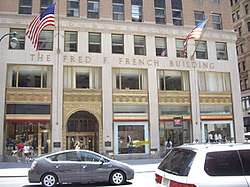Fred F. French
Frederick Fillmore French (October 14, 1883 – August 30, 1936) was a real estate developer.
Frederick Fillmore French | |
|---|---|
| Born | October 14, 1883 |
| Died | August 30, 1936 (aged 52) |
| Education | Horace Mann School |
| Occupation | Real estate developer |
| Known for | Tudor City Knickerbocker Village Fred F. French Building |
| Spouse(s) | Cordelia W. French |
| Children | 4 |
Biography
He was born in Manhattan, New York City on October 14, 1883. His middle name, Fillmore, was an ode to his distant relative, President Millard Fillmore.[1] He grew up in the Bronx and attended the Horace Mann School.[2]
Career
He built Tudor City, a housing development on Manhattan's East Side, for the rising middle class in the 1920s.[3] He also developed Knickerbocker Village, middle-class housing on the Lower East Side between the Brooklyn Bridge and the Manhattan Bridge. His original intention for the project was to build housing for "junior Wall Street executives".[4] His Fred F. French Building is a well-known skyscraper on Fifth Avenue in Midtown.
French and his company served as the developer and landlord of Knickerbocker Village, important in the history of landlord–tenant law. When the tenants were to take possession of their apartments, they found conditions to be unlivable.[5] Facilities were either unfinished or poorly equipped, including non-working elevators and inoperable laundry rooms.[6] The tenants formed the Knickerbocker Village Tenants Association and started a strike, withholding their rent checks until their grievances were dealt with. The conflict that arose from the tenants' dissatisfaction led to New York City's rent control laws.
Personal life
French was married to Cordelia Williams, with whom he had four children:[7]
- Theodore French
- John Winslow French (1918–1999), who married Adeline Greer.[8]
- Frederick F. French, Jr.
- Ellen Millard French, who married Ernest McKay.[1]
The Frenches lived at 1140 Fifth Avenue in New York City.[7] He died on August 30, 1936, of a heart attack at his summer home, Hammersley Hills, in Pawling, New York, that he had been going to since 1929.[9][10] His estate was valued at under $10,000 and did not include any real estate holdings.[11]
Legacy
The life of Fred F French and his contribution to the development of New York City was covered in detail by Alexander Rayden in "The People's City, A History of the Influence and Contribution of Mass Real Estate Syndication in the Development of New York City". [12][13]
References
- Alpern, Andrew (1992). Luxury Apartment Houses of Manhattan: An Illustrated History. New York: Dover Publications. ISBN 9780486273709. Retrieved 28 October 2016.
- "Irving S. Broun, Realty Man, Dies. Retired President of Fred French Investing Was 82". the New York Times. January 4, 1969. Retrieved 2009-01-14.
He had attended the Horace Mann School with the late Fred F. French and later helped him plan the erection and promotion of Tudor City, ...
- "Mrs. Frederick French". The New York Times. October 31, 1960. Retrieved 2009-01-14.
Her husband, who died in 1936, was chairman of the Fred F. French Companies, which built Tudor City and other large developments. Surviving are a daughter ...
- "Knickerbocker Village". Time magazine. October 15, 1934. Retrieved 2009-01-14.
In 1929 Realtor Fred Fillmore French began buying land on the lower East Side. By swearing his 42 brokers to secrecy and using dummy corporations, he managed to get some 15 acres for $5,000,000. Then in 1931 he announced a grandiose scheme for the erection of a $50,000,000 development for junior Wall Street executives. At this point he found that he could not get credit. At the same time Fred F. French Operators, Inc. began passing its dividends on $14,000,000 of preferred stock. The project remained only a scheme with a staggering upkeep in land taxes.
- Morrison, James. "Who in the World Was Fred F. French?". City Journal (Autumn 1998). Retrieved 2008-05-04.
- Naison, Mark. "From Eviction Resistance to Rent Control – Tenant Activism in the Great Depression: The rebirth of Activism". In Lawson, Ronald; Naison, Mark (eds.). The Tenant Movement in New York City, 1904-1984. ISBN 0-8135-1203-4. Retrieved 2008-05-04.
- Special To The New York Times (31 August 1936). "FRED F. FREHGH DIES $tlDDEHLY IJP-STATE; Leader in Developing New York Residential Sections Rose From Poverty, HAD NOVEL FINANCE PLAN Tudor .City and Knickerbocker; Village Were the Builder's Chief Accomplishments,". The New York Times. Retrieved 28 October 2016.
- "John Winslow French '39 *42". Princeton Alumni Weekly. 21 January 2016. Retrieved 28 October 2016.
- "Died". Time magazine. September 7, 1936. Retrieved 2009-01-14.
Frederick Fillmore French, 52, Manhattan builder (Tudor City, Knickerbocker Village); of angina pectoris; in Pawling, N. Y. An admirer of the late Thomas Edison, he worked late, slept little, never drank or attended the theatre, assigned his staff daily readings in Elbert Hubbard.
- "Fred F. French Dies Suddenly". The New York Times. August 30, 1936. Retrieved 2009-01-14.
Leader in Developing New York Residential Sections Rose From Poverty. Tudor City and Knickerbocker Village Were the Builder's Chief Accomplishments.
- "F.F. FRENCH'S WILL FILED; Builder's Estate, With No Realty, Valued at 'Less Than $10,000.'". The New York Times. September 4, 1936. Retrieved 28 October 2016.
- www.thepeoplescity.com
- Greg Aunapu (29 May 2009). "'French Plan' ahead of its time". The Real Deal New York.
